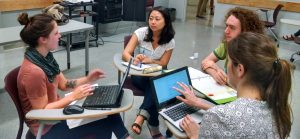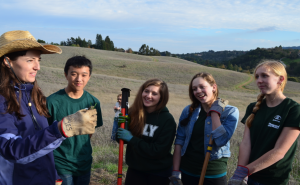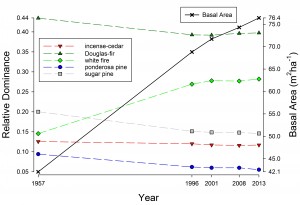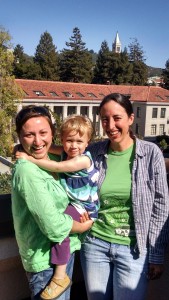Con gratulations to Carrie Levine and Joan Dudney for receiving UC Berkeley’s Outstanding 2016 Graduate Student Instructor Award. Carrie was acknowledge for her work in ESPM 100ES: Introduction to Methods in Environmental Science. This is a required class exclusively for juniors in Environmental Science. Methods are rarely the most interesting topic of study but essential to good science. Carrie’ was noted for her aptitude in mentoring young scientists: “She helped students to think for themselves – a key goal of this course – while also holding them accountable for
gratulations to Carrie Levine and Joan Dudney for receiving UC Berkeley’s Outstanding 2016 Graduate Student Instructor Award. Carrie was acknowledge for her work in ESPM 100ES: Introduction to Methods in Environmental Science. This is a required class exclusively for juniors in Environmental Science. Methods are rarely the most interesting topic of study but essential to good science. Carrie’ was noted for her aptitude in mentoring young scientists: “She helped students to think for themselves – a key goal of this course – while also holding them accountable for  making the effort.” Joan earned her award for her teaching in ESPM C11: Americans and the Global Forests. This introductory course challenges students to think about how natural resource management and human values affect forest ecosystems around the world. Joan’s nomination letter praised her ability to connect with the diverse students who take this course and to inspire them to think more carefully about the natural world.
making the effort.” Joan earned her award for her teaching in ESPM C11: Americans and the Global Forests. This introductory course challenges students to think about how natural resource management and human values affect forest ecosystems around the world. Joan’s nomination letter praised her ability to connect with the diverse students who take this course and to inspire them to think more carefully about the natural world.
Author: John Battles
Old-growth forest dynamics in the Sierra Nevada
Lab members past and present collaborated on a recent paper documenting ecosystem dynamics and tree demography over the past half-century. In the mid-1950’s Professor Frederick Baker (former Cal Forestry School Dean) established a 4 ha mapped stand of old-growth mixed conifer forest in northern California. In 1996, Jolie-Ann Ansley re-established the “Baker Plot” and we have been following the dynamics since.

The most recent paper in the Canadian Journal of Forest Research, Levine et al. (In press) found that despite a warming climate, stand density, basal area, and carbon have increased over 56 years. Fir recruitment and growth significantly exceeded the community-level median rates, while pine recruitment and growth was significantly lower than the community-level median. Shifts in species composition from a well-mixed stand to a more dense fir-dominated stand appear to be driven by low growth and recruitment rates of pines relative to firs.
Congratulations to Lab Alumni

Congratulations to Dr. Maya Hayden who completed her PhD this August. Her dissertation, “Abandoned Channels as Refugia for Sustaining Pioneer Riparian Forests” combined field data with mesocosm experiments to explore controls on cottonwood recruitment dynamics along the Sacramento River in Northern California. Dr. Hayden will continue her education as a California Sea Grant Fellow working with the NOAA San Francisco Bay and Outer Coast Sentinel Site Cooperative (NOAA Sentinel Site).
Congratulations also to Dr. Natalie van Doorn (PhD 2014), a post-doctoral fellow at UC Davis. Dr. van Doorn was recently appointed as a research urban ecologist with the USFS Pacific Southwest Research Station (PSW). She will be working out of the Albany, CA office where she will continue her research on street tree demography and climate-ready trees for urban ecosystems.
